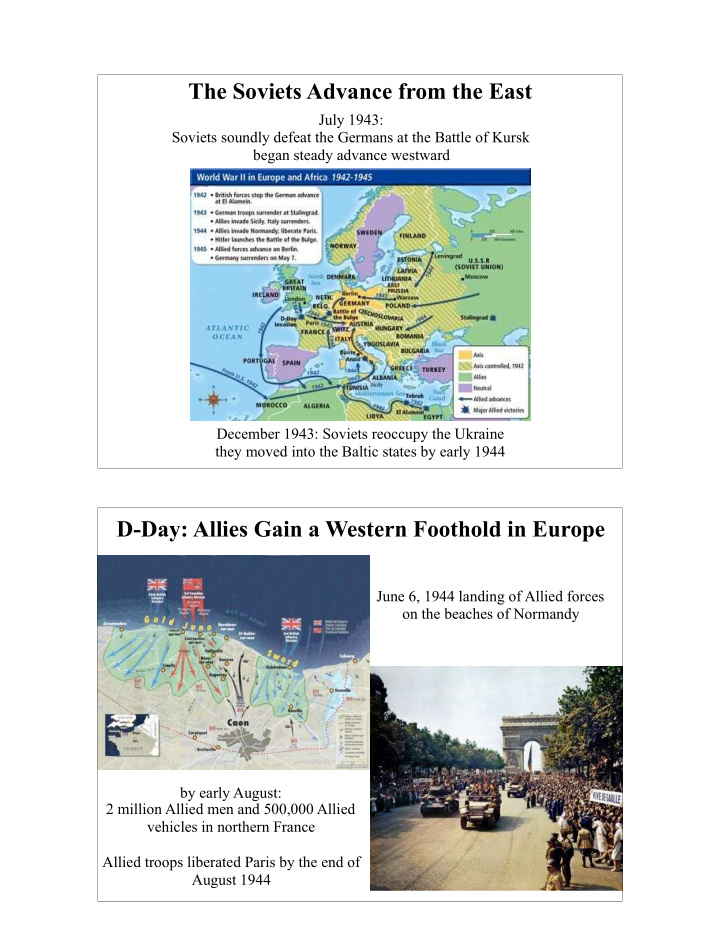



The Soviets Advance from the East July 1943: Soviets soundly defeat the Germans at the Battle of Kursk began steady advance westward December 1943: Soviets reoccupy the Ukraine they moved into the Baltic states by early 1944 D-Day: Allies Gain a Western Foothold in Europe June 6, 1944 landing of Allied forces on the beaches of Normandy by early August: 2 million Allied men and 500,000 Allied vehicles in northern France Allied troops liberated Paris by the end of August 1944
The Battle of the Bulge December, 1944: Germans launch counteroffensive, creating a “bulge” in Allied lines but the Allied lines held March 1945: Allied forces cross the Rhine River and advanced into Germany April 1945: Allied armies in northern Germany link up with the Soviets Meanwhile, on the Eastern Front: January 1945: Soviet troops occupy Warsaw April 1945: Soviet troops enter Berlin The War in Italy July, 1943: King Victor Emmanuel III gains control of the Italian military he dismissed Mussolini as prime minister and immediately imprisoned him the new Italian government began negotiations with the Allies September, 1943: armistice signed with the Allies December, 1943: Germans rescue Mussolini moves to northern Italy sets up a new Fascist state April 28, 1945: Mussolini captured and killed by the Italian resistance May 2, 1945: German and Italian forces in Italy surrendered
Hitler’s Demise By January 1945, Adolf Hitler had moved into a bunker 55 feet under the city of Berlin. He continued to blame the Jews for the war. He wrote: Above all I charge the leaders of the nation and those under them to scrupulous observance of the laws of race and to merciless opposition to the universal poisoner of all peoples, international Jewry. from Hitler’s Final Will and Testament, April 29, 1945 Hitler committed suicide on April 30, 1945. On May 7, 1945, Germany surrendered. The war in Europe was finally over. Germany is Defeated Stalin, Roosevelt, and Churchill had met at Tehran in November 1943 to discuss an Allied invasion through France scheduled for the spring of 1944 (D-Day). Soviet and British-American forces would meet in defeated Germany along a dividing line. 11 million Soviet soldiers would be taking possession of Eastern Europe. The Allies also agreed to a partition of postwar Germany. Yalta Conference: February 1945 the Big Three met again at in southern Russia Stalin wanted to establish pro-Soviet governments along the Soviet Union’s borders, control of the Sakhalin and the Kuril Islands, and two warm-water ports and railroad rights in Manchuria this was Stalin’s price for military aid against Japan
A Divided Germany Germany was divided into four zones for the Allied countries to occupy and govern US, Great Britain, France, the Soviet Union July 1945: Potsdam Conference Big Three met to discuss the issue of free elections Roosevelt favored the idea of self-determination Stalin responded, “A freely elected government in any of these East European countries would be anti- Soviet, and that we cannot allow.” British Prime Minister Clement Attlee, US President Harry Truman and Soviet Premier Joseph Stalin at the Potsdam Conference, July - August 1945 The Asian Theater 1943: U.S. began an island-hopping offensive against Japan early 1945: US controls the islands of Iwo Jima and Okinawa Iwo Jima had two airfields used by the Japanese to attack Allied aircraft Okinawa would also provide them with a base near the mainland The Allies were victorious in both battles, but casualties were great on both sides.
The Manhattan Project President Harry S. Truman had been sworn in after Roosevelt died in April Truman was convinced that a US invasion of Japan would incur heavy casualties scientists in America had secretly developed the atomic bomb as part of the Manhattan Project Truman made the difficult decision to use the bombs against Japan Hiroshima was bombed on August 6 and three days later, a second bomb was dropped on Nagasaki Thousands of people died immediately after the bombs were dropped. Thousands more died in later months from radiation. Emperor Hirohito accepted unconditional surrender terms on August 14, 1945. World War II was finally over. The Cold War Begins the world had witnessed the deadly potential of nuclear energy countries raced to build their own nuclear weapons. August 1949: the Soviet Union set off its first atomic bomb Western countries thought Soviet expansionist policy was part of a worldwide Communist conspiracy. The Soviets viewed Western policy as global capitalist expansionism. March 1946: former British prime minister Winston Churchill declared that “an iron curtain” had “descended across the continent,” dividing Europe into two hostile camps. The Cold War: period of political tensions between the US and the Soviet Union following WWII, a situation that would dominate world affairs until the end of the 1980s.
Recommend
More recommend